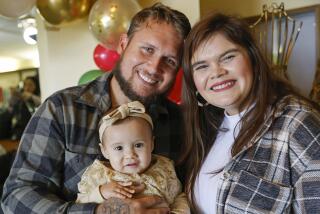School Is a Balancing Act for Youngsters in the Circus
When Jim Boyd asks his students to solve math problems, he has them figure out how tall an elephant is. Or he asks them how many balls there are if five clowns are juggling three balls each.
Boyd is the sole tutor of the 18 school-age children who live on the road with the Ringling Bros. and Barnum & Bailey Circus.
Although as a child he never dreamed of running away with the circus, he has done just that. And he says nothing could persuade him at this point to return to public school teaching.
“It’s rewarding educationally, because you don’t have as much paper work as in the public schools,” he said of his job. “I can focus all my time with the kids and (on) getting feedback from them.”
He also enjoys a certain status in the circus that he might not have in a more conventional environment.
A ‘European’ Attitude
“I’m looked on as a professional here,” Boyd said. “Education is a high priority. I think it is the European way of thinking.”
Circus parents are concerned about their children’s education, Boyd said. He said that when he has a problem with a child, he usually can clear it up the same day by speaking with the child’s parents.
Boyd, of Sarasota, Fla., has taught math and science at elementary, junior high and high school levels. He said his experience with so many grades helped him land the circus job last August.
In a 10-hour workday, Boyd meets with small groups of students in two-hour sessions. Though math, including trigonometry, is his specialty, Boyd also teaches the usual school subjects.
The study groups are formed according to circus acts, not the children’s ages, and meeting times are fit into circus schedules. There may be five grade levels represented in a single group.
Performances Come First
Because of the show, Boyd can’t keep students after class. Performances and even publicity interviews can take priority over class time.
The kids often put in eight to 12 hours of circus-related work each day, so Boyd tries not to hold classes after performances.
The circus students are enrolled in accredited correspondence schools. They are not graded by Boyd, but take standardized tests that are mailed to the correspondence schools.
Mark Gebel, 16, the son of animal-tamer Gunther Gebel-Williams, said Boyd is helpful and patient, and he believes he is getting the same level of education with Boyd as he would in a public school.
Although Gebel, who was born into a circus family, misses spending more time with students his age, he said he wouldn’t give up the benefits of circus life.
Gebel will be a senior in Boyd’s classes next year. He plans to go on to college, but wants to return to the circus, he said.
That balance of loving the circus but having other goals, such as higher education, is typical among circus kids, Boyd said.
More to Read
Sign up for Essential California
The most important California stories and recommendations in your inbox every morning.
You may occasionally receive promotional content from the Los Angeles Times.










